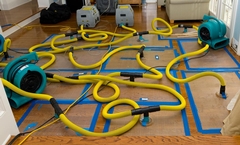
In the blink of an eye, a small leak can turn into an expensive water damage crisis, a flicker can escalate into a raging fire, and an unnoticed damp spot can transform into a mold infestation. Such emergencies can disrupt lives and devastate properties. According to a study by the Global Alliance on Health and Pollution, the impact of indoor pollution-including fire and mold-affects millions of people worldwide each year. But what if there were ways to mitigate these disasters effectively and efficiently? Welcome to the advancing world of water, fire, and mold damage restoration.
In Wisconsin, today's damage restoration companies in Milwaukee are not only about repairing damage but also about preventing future incidents through innovation and technology. These innovations are not just technical breakthroughs; they offer real-world solutions to real problems encountered by property owners.
In this blog post, we'll explore the latest technologies and techniques that are redefining water, fire, and mold damage restoration. We'll dive into practical solutions that offer not just temporary relief but long-term peace of mind.
The Game-Changing Technologies in Water Damage Restoration
1. Advanced Drying Techniques
Water damage can wreak havoc on a property, penetrating walls, flooring, and furniture. Traditional methods of drying could take weeks, often leading to secondary damages like mold. However, innovative drying techniques have revolutionized the process:
- Desiccant Dehumidifiers: Unlike conventional dehumidifiers, desiccant models can operate efficiently in colder temperatures, extracting moisture at a much faster rate.
- Heat Drying Systems: These systems accelerate evaporation and reduce drying times significantly, preserving structural integrity and preventing mold growth.
These technologies not only save time and money but also reduce potential environmental impacts by lowering energy consumption. RestoreMore's water damage restoration services in Milwaukee ensure the implementation of these advanced drying techniques for faster water damage mitigation.
2. Water Leak Detection Sensors
Prevention is better than cure. Modern sensor technology can alert homeowners to leaks before they cause significant damage:
- Smart Water Sensors: These devices can be installed in vulnerable areas to detect moisture and send alerts to a phone app, allowing for immediate action.
Fire Damage Restoration Innovations
1. Smoke Odor Removal Techniques
One of the most challenging aspects of fire restoration is removing the pervasive smoke odor:
- Ozone Generators: These machines neutralize smoke odors by breaking down odor-causing molecules.
- Hydroxyl Generators: A safe alternative to ozone, hydroxyl generators can be used in inhabited spaces, accelerating the deodorization process.
2. Fire-Resistant Building Materials
In the wake of a fire, the reconstruction phase offers an opportunity to enhance safety with fire-resistant materials:
- Intumescent Paints: This type of paint expands when exposed to heat, providing an insulating barrier that can delay fire spread.
- Gypsum Board: Known for its fire-resistance properties, gypsum board is increasingly used in walls and ceilings to limit fire damage.
These materials not only improve safety but also increase a property's value by reducing fire risks.
Mold Damage Restoration Breakthroughs
1. Infrared Camera Inspections
Detecting mold is often challenging, as it can grow unseen behind walls and floors. Infrared technology has changed the game:
- Thermal Imaging Cameras: These cameras detect temperature differences, identifying hidden moisture pockets conducive to mold growth.
2. Biological Treatments
Traditional mold removal often involves harsh chemicals, but advancements in biological treatments offer safer alternatives:
- Enzyme-Based Cleaners: These solutions target and digest mold spores without damaging surfaces or harming occupants.
Challenges and Opportunities in the Restoration Industry
The rapid pace of technological advancement comes with its own set of challenges. Adapting to new technologies requires substantial investment and training. However, the benefits far outweigh the hurdles. Implementing these innovations can revolutionize client satisfaction by speeding up recovery times and minimizing disruptions.
Actionable Strategies for Property Owners
Utilizing these innovations does not just fall on restoration companies-property owners also play a crucial role. Here are some strategies:
- Regular Maintenance: Conduct routine checks of vulnerable areas, such as basements and attics, to quickly spot early signs of water, fire, or mold issues.
- Emergency Readiness Plan: Equip your property with the latest sensors and alarms, and outline a clear action plan in case of an emergency.
- Stay Informed: Keep abreast of local regulations and innovations in the industry to make informed decisions about property safety and improvements.
Restore and Protect with Innovation: Trust RestoreMore for Future-Ready Solutions
The world of water, fire, and mold damage restoration is evolving rapidly, driven by technological advances and a growing awareness of sustainable practices. As we have explored, these innovations are not merely theoretical-they are proven, practical solutions that are already being implemented with outstanding success. Leveraging these advancements can ensure that properties are not only restored to their former glory but are also fortified against future damage.
For property owners and businesses in need of professional restoration services, partnering with leaders like RestoreMore can ensure expert guidance and cutting-edge solutions. Contact us now to discover how our expertise can serve you. Whether you are exploring fire damage restoration services in Brookfield or mold remediation in Franklin, we're here to help.
In tackling today's restoration challenges, the integration of innovative technologies provides more than a solution; it offers peace of mind. With a clear understanding and application of these advances, we can not only restore but also protect our spaces against future adversities.